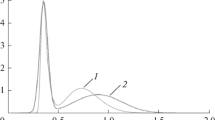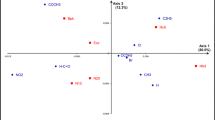Summary
Using a camomile flavonoid extract as the sample and four different reversed-phase partition systems, the ability of the Simplex procedure to produce optimum gradient separation of unknown multicomponent mixtures was checked against the linear solvent strength (LSS) gradient elution theory. On the same partition systems the mean solvent strenghts were measured by experimentally determined logk′ vs. mobile phase composition plots. These mean solvent strengths are compared to those inferred from the optimum gradients and the usefulness of LSS theory in multicomponent mixture gradient elution optimization is discussed.
Similar content being viewed by others
References
L. R. Snyder, in “High-Performance Liquid Chromatography; Advances and Perspectives” Vol. 1C. Horváth ed., Academic Press, New York, 1980, pp. 207–316.
J. C. Berridge, “Techniques for the automated optimization of HPLC Separation”, J. Wiley and Sons; Chichester, 1986.
L. R. Snyder, J. W. Dolan, J. R. Gant, J. Chromatogr.165, 3 (1979).
J. W. Dolan, J. R. Gant, L. R. Snyder, J. Chromatogr.,165, 31 (1979).
P. Janders, J. Churacek, J. Chromatogr.,192, 19 (1980).
M. A. Stadalius, H. S. Gold, L. R. Snyder, J. Chromatogr.,296, 31 (1984).
H. K. Smith, W. L. Switzer, G. W. Martin, S. A. Benzera, W. P. Wilson, D. W. Dixon J. Chromatogr. Sci.,24, 70 (1986).
M. Martin, G. Guiochon, Anal. Chem.,57, 289 (1985).
J. C. Davis, J. C. Giddings, Anal. Chem.55, 418 (1983).
F. Dondi, Y. D. Kahie, G. Lodi, M. Remelli, P. L. Reschiglian, C. Bighi, Anal. Chim. Acta in press.
L. Morgan, S. N. Deming, INSTRUMENTUNE-UP Program, Elsevier Scientific Software. Amsterdam, 1984.
L. J. Nagels, W. L. Creten, Vanpeperstraete, Anal. Chem.,55, 216 (1983).
K. A. Cohen, J. W. Dolan, S. A. Grielo, J. Chromatogr.,316, 359 (1984).
P. J. Schoenmakers, H. A. H. Bielet, L. de Galan, J. Chromatogr.,198, 179 (1979).
M. A. Quarry, R. L. Grob, L. R. Snyder, J. Chromatogr.,285, 1 (1984).
Author information
Authors and Affiliations
Additional information
Dadicated to Prof. Dr. A Liberti on the occasion of his 70th birthday.
Rights and permissions
About this article
Cite this article
Dondi, F., Kahie, Y.D., Lodi, G. et al. Comparison of the sequential simplex method and linear solvent strength theory in HPLC gradient elution optimization of multicomponent flavonoid mixtures. Chromatographia 23, 844–849 (1987). https://doi.org/10.1007/BF02311411
Received:
Accepted:
Issue Date:
DOI: https://doi.org/10.1007/BF02311411




